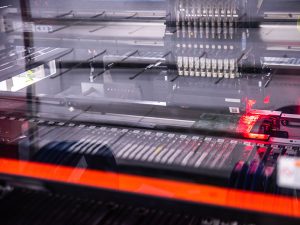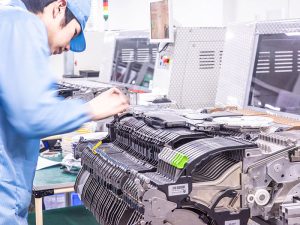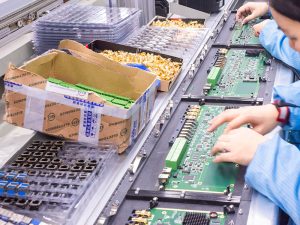Table of Contents
ToggleWhile the terms SMT and SMD may seem identical at first glance, they are quite different, and understanding these differences is important in modern electronics assembly.
In this guide, we’ll look at their differences, applications, and advantages in the industrial world. Let’s dive in!
 What is SMT?
What is SMT?
SMT is an acronym that stands for Surface Mount Technology. It refers to the method of electronic component assembly where the components are mounted or placed directly onto the surface of a printed circuit board (PCB).
This is different from through-hole technology, where holes are drilled into the PCB, and the original components are inserted into the drilled holes in the PCB. SMT components are much smaller in size compared to through-hole components, allowing for greater circuit density and efficiency.
 What Does The SMT Assembly Process Look Like?
What Does The SMT Assembly Process Look Like?
The process of SMT involves soldering the components onto the surface of the SMT PCB board using a soldering technique. In simple terms, this means applying solder paste to the pads on the SMT PCB board, placing the SMT components on the paste, and then using heat to melt the solder and create a permanent bond between the component and the board.
This process is typically done using specialized equipment like reflow ovens or soldering irons to ensure precise and accurate placement of components. The precision and accuracy of this process are crucial to ensure the proper functioning of the electronic components in the final product.
What Are The Advantages Of The SMT Assembly Process?
Some advantages of the SMT assembly process include
- SMT components do not require holes drilled in the SMT PCB board. This allows for a smaller board size and improved electrical performance. This size reduction also leads to lighter and more compact electronic devices ideal for portable applications.
- In addition, the automated nature of SMT assembly results in faster production speeds, which in turn, leads to lower manufacturing costs.
 What is SMD?
What is SMD?
SMD is an acronym for Surface Mount Device. Unlike SMT, which refers to the assembly process, SMD specifically denotes the electronic components themselves. These components are designed to be placed and soldered directly onto the surface of a PCB without needing any holes for mounting.
SMD components come in a variety of shapes and sizes, ranging from resistors and capacitors to integrated circuits and connectors.
They offer a higher level of integration and performance compared to through-hole components which makes them ideal for modern electronic devices that require compact size and high functionality.
 Features Of Surface Mounted Device(SMD)
Features Of Surface Mounted Device(SMD)
Some features of SMD include
- SMD components are typically lighter in weight and have better high-frequency characteristics due to their shorter lead lengths. This makes them ideal for applications requiring high-speed data processing or wireless communication.
- Also, the smaller size of SMD components allows for higher circuit density which enables more complex electronic devices to be designed with smaller footprints.
SMT and SMD: The Differences
Here are some major differences you need to know about SMT and SMD.
- First off, as mentioned earlier, SMT refers to the process of soldering components onto a PCB, while SMD specifically pertains to the electronic components used in this process.
This particular distinction between SMT and SMD lies in their respective roles in the overall assembly of electronic devices. - Another important difference to note is that SMT assembly is a broader term that encompasses the entire process of mounting and soldering components onto a PCB (including both SMD and other types of components like through-hole).
- On the other hand, SMD specifically refers to the type of components that are mounted directly onto the surface of the board.
The Bottom Line
There you have it. Although SMT and SMD sound similar, they do have differences. If you have more questions, don’t hesitate to visit our FAQ page. Also, check out our top-notch services for your PCB assembly needs.
To success!









